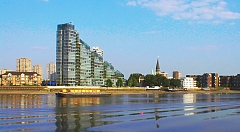|
|
 |
|
Wandsworth
|
 |
An increasingly upmarket district that nevertheless retains many council-built flats, situated on the south bank of the Thames,
north-east of Wandsworth. It is one of the oldest recorded place names in the London area. A late seventh-century charter
makes reference to ‘Badrices ege’, the island of a man called Badric. The parish church of St Mary was in existence
by 1157, although nothing of the original structure has survived. The Abbey of Westminster held the manor at the time of the
dissolution of the monasteries, when it passed to the Crown, and then in 1627 to the St John family, whose manor house stood
east of the church. Industries were established on reclaimed marshland beside the Thames, including a shot foundry, a whiting
(whitewash) works and a brewhouse at Nine Elms. From the 1740s to 1756, decorative enamel boxes were made at York House, and
several other manufacturing businesses were equally short-lived. St Mary’s Church was rebuilt in the mid 1770s. Most
of the manor house was demolished in 1793, and later became the site of flour mills. Away from the river, most of Battersea
was used for market gardening, with a few clusters of dwellings around the church and in Falcon Road and Bolingbroke Grove.
The coming of the railway to Nine Elms and Clapham Junction and in 1858 the simultaneous opening of Chelsea Bridge and Battersea
Park prompted developers to lay out estates of reasonably priced housing for the middle classes all along the route to Clapham Common. Shortly afterwards, however, Battersea was divided up by an increasing number of railway lines and as a result property
prices dropped, with some of the larger houses being subdivided to allow occupation by ‘persons of humbler circumstances’.
New stations were opened at Battersea Park and Queenstown Road and grids of terraced cottages were laid out, including in
the 1870s the Shaftesbury Park estate, the work of the same philanthropic company that later built Queen’s Park. By 1871 the population of Battersea had increased almost tenfold in 40 years and it tripled again before the end of the
19th century, when most of the residents were skilled artisans employed in local service industries. The Latchmere estate
of 1903 was the first to be built by an London County Council borough. Battersea council was a famously progressive body,
in 1906 gaining the first British-born black councillor, John Richard Archer. In 1913 Archer was elected mayor, another first.
 |
 |
|
|
|
 |
|
Behind the upmarket riverside apartment complexes, Battersea has many blocks of council-built flats, most of which are now
owner-occupied
Blocks of municipal flats replaced much of Battersea’s Victorian housing before and for several decades after World
War II. The most unspoilt part is the old village, south of the church. In recent years, much of the riverside has filled
with luxury apartment complexes, of which the most impressive is the Montevetro building (shown below, left). Price’s
candle factory, which took the place of York House, has been converted into flats.
Battersea was the birthplace of the jazz pianist George Shearing and the TV personality Michael Aspel. Other former residents
include the author GK Chesterton and the artist-craftsman Eric Gill.
|
 |
|
|
|
|
|
Postal district: SW11
Population: 62,811 (Latchmere, Northcote, Queenstown, St Mary’s Park and Shaftesbury wards)
Further reading: Patrick Loobey, Battersea Past, Historical Publications, 2002
Chambers London Gazetteer has additional entries for the Battersea area, including Battersea Park, Queenstown Road
and Nine Elms.
Text and selected images are reproduced with the permission
of Chambers but may differ from the published versions
All content © 2005–2010
|
|
|
 |

